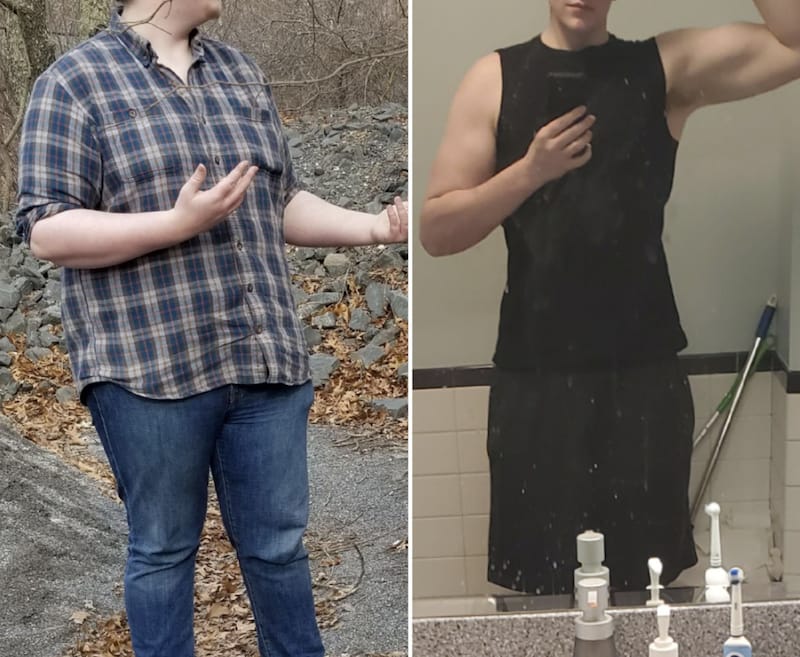Alternate-Day Fasting: The Newcomer's Guide
Here’s everything you need to know about alternate-day fasting, including the theory behind it, adaptation time, health benefits, and risks.

New to intermittent fasting?
If so, you’re likely searching for a calorie restriction diet that fits your lifestyle. There’s a lot to choose from, as the various modifications have made intermittent fasting accessible to everyone.
Lots of us turn to a fasting schedule for weight maintenance and weight loss purposes. And aside from reaching your body weight goals, intermittent fasting brings an abundance of health benefits, such as lowering the risk of cardiovascular disease.
Switching between fasting days could be the answer if you’re looking for an intermittent fasting schedule with a bit of wiggle room. Many people find this approach easier to sustain as it doesn’t include a daily calorie restriction.
This article brings you a comprehensive guide to the alternate-day fasting diet. Let’s begin.
What Is Alternate-Day Fasting?
Alternate-day fasting (ADF) is an intermittent fasting (IF) diet plan. The immediate feature of this diet is an eating pattern that involves fasting every other day. On non-fasting days, you can eat as you wish.
Although there is no calorie restriction on non-fasting days, your calorie count on fasting days can vary. Some alternate-day fasters practice a strict diet where all calories are off the table on fasting days.
The majority, however, follow a modified version that permits you to consume around 500 calories on fasting days, approximately 25% of your daily calorie intake.
How does it work?
The alternate-day fasting schedule works by restricting calories every other day. It means that you can eat as normal 50% of the time without monitoring your food intake every day.
The basics of intermittent fasting encourage weight loss through continuous calorie restriction. It prolongs the period where the body burns through the calories provided from your last meal, forcing the body to convert its fat stores into fuel, resulting in fat loss.
ADF and other tailored fasting regimens require a significant shift from your usual eating habits, so it can be difficult to adapt. That’s where you can benefit from a fasting app like DoFasting.
Voluntary abstinence is tricky to manage, but you can remain on track with tailored technology. The DoFasting app supplies you with all the tools necessary to achieve your goals, whether you want to lose weight, get fit, or detox your body.
You can access quick-prep recipes, home workout tutorials, and meal recommendations from a nutritionist team that guarantees results.
How to Do Alternate-Day Fasting
If you follow the most extreme form of the diet, you must abstain from eating any food during the fasting periods. It permits only calorie-free drinks or very-low-calorie beverages during this time to maintain hydration.
That means you can drink as much water as you like, but you can also drink black coffee or tea without any sugar or sweeteners.
With the revised version, you can consume around 500 calories on fasting days (25% of energy needs), which you can spread across the day or consume in one sitting. The idea is that you can still benefit from fasting with a small calorie intake.
Although the diet doesn’t state what you can and can’t eat on non-fasting days, it’s better for your overall health to eat a healthy diet with nutrient-dense foods. Junk food and other processed foods won’t benefit you in the long term.
How long does it take to adapt to alternate-day fasting?
It can take 2–4 weeks for the body to adapt to an alternate-day fasting regimen. You might initially feel irritable dealing with hunger pangs, but adverse effects can soon subside once you notice the benefits.
Adapting to your new meal timing can take time, although some people find the alternate-day fasting plan easier to sustain due to the cycles between fasting and normal eating.
As with any other diet, the adaptation period can vary from person to person. Some may adjust relatively quickly, while others may need additional time synchronizing with alternate-day fasting.
Is Alternate-Day Fasting Effective for Weight Loss?
As with other forms of fasting, alternate-day fasting can be effective for weight loss, and you can lose 1–2 pounds in a week.
This is primarily due to calorie restriction, as alternate-day fasting limits the times you can eat. You’re no longer eating as many calories as you usually would in a week.
When you restrict yourself from food, your body exhausts glucose stores that it ordinarily uses for energy. It triggers a metabolic switch, where the body begins burning fat for energy instead. This function promotes weight loss as you burn through your stored fat.
One study concluded that alternate-day fasting effectively lowers body mass index and total cholesterol in overweight adults within six months.
A randomized clinical trial comparing alternate-day fasting to daily calorie restriction in metabolically healthy obese adults determined limited results. The results were no more or less effective for weight loss in the alternate-day fasting group than in the calorie restriction group.
Alternate-Day Fasting: Before and After
If you’re curious about the weight loss effects of alternate-day fasts, see the images below for actual results from real-life alternate-day fasters.



Alternate-Day Fasting vs. Intermittent Fasting
The alternate-day fasting schedule is a form of intermittent fasting. It’s done a little differently than the best-known 16:8 fast, as you can consume up to 500 calories per day when doing alternate-day fasting.
Intermittent fasting refers to periods of cycling between meal-timing schedules and regular eating. There are numerous schedules you can follow depending on your preferences.
For instance, many intermittent fasting regimens isolate certain hours of the day for eating. You may eat breakfast one morning and fast until the following morning.
ADF is popular because it allows you a period of normality. Essentially, you only need to restrict calories half of the time rather than watch what you eat every day.
Benefits of Alternate-Day Fasting
The ADF method brings promise for many health outcomes. Here are 4 health benefits linked to the alternate fast diet.
#1 Reduced heart disease risk
Fasting is associated with better heart health and the potential reduction in chronic health conditions.
The ADF diet may be a viable option in helping overweight and obese patients lose weight, simultaneously lowering the risk of heart disease.
Fasting can help reduce blood pressure, decrease LDL cholesterol levels, and reduce overall body weight. High blood pressure, cholesterol, and weight are primary factors contributing to heart disease. In reducing all three, heart disease risk is limited.
#2 Autophagy
Autophagy is the natural cell degradation process that removes and recycles old or damaged cellular components. It helps with disease prevention and may even delay the aging process.
Fasting and dietary restriction can induce autophagy as the body responds to food abstinence, which may help people live longer. Animal studies show a link between increased autophagy and longevity in mice.
#3 Weight loss
Most participants try alternate-day fasting to promote weight loss quickly and effectively or use it to aid weight management.
As food restriction exhausts sugar stores, your body moves into fat-burning mode, promoting weight loss and healthy body composition.
The regime may also cause hormonal changes that suppress appetite, lowering hunger hormones and increasing satiety hormones. This means you don’t feel as hungry, reducing cravings and the risk of binge eating.
Although it’s been practiced since ancient times, voluntary abstinence is particularly challenging in the modern world, with constant access to tasty, high-calorie foods.
Luckily, the world of technology makes losing weight more accessible. The DoFasting app can assist you in managing your new eating routine with thousands of recipes, calorie tracking, and even progress tracking.
DoFasting turns alternate-day fasting into a lifestyle rather than a quick fix with consistency and daily motivation.
#4 Reduced blood glucose levels
Some evidence suggests that fasting can serve as a non-medical treatment for people with type 2 diabetes as it reduces blood sugar levels.
It may effectively decrease fasting glucose and insulin levels and reduce insulin resistance.
However, alternate-day fasting should not be used as a treatment method for diabetes without medical supervision.
Can You Drink Water During Alternate-Day Fasting?
Yes! Water is a requisite of the alternate-day fasting diet, and you have to drink around 10 glasses of water a day if you want to feel energized and stay healthy.
The human body needs water to function, and as food accounts for about 20% of your daily water intake, it becomes even more vital when fasting.
Water is calorie-free, so you can drink as much of it as you like without breaking your fast. You can even try alternatives to introduce a kick to your routines, such as sparkling water, lemon water, and herbal teas.
Risks of Alternate-Day Fasting
No matter the diet, there is always a risk factor. The alternate-day fasting schedule is safe for most healthy adults, but it is not suitable for everyone.
Certain groups should avoid it, including children, pregnant and breastfeeding women, and those with a history of eating disorders.
It’s critical for people with ongoing health conditions to speak with a doctor before attempting alternate-day fasting or fasting of any kind.
#1 Depressive symptoms
Despite the many benefits of alternate-day fasting, it can harm mental well-being. It’s not uncommon for calorie-restricting diets to affect your mood, triggering negative feelings, notably irritability.
Excessive calorie restriction can impair cognitive abilities, leading to a lower quality of life that causes negative moods.
If the diet begins to limit your social interactions due to meal timings, you may develop a low mood.
This type of dieting can also trigger a past eating disorder, which is why IF is never recommended for individuals with eating disorders.
#2 Constipation
It’s not uncommon for diets to throw your bowel habits out of sync, especially in the early stages as you adapt to a new routine. You can experience constipation when trying to adapt to a new routine.
With alternate-day fasting, this may be attributed to a lower dietary fiber intake from days without food.
There is also the risk of dehydration as you no longer receive water from foods. A lack of water and fiber in the diet can quickly lead to constipation, making the stool hard to pass.
#3 Weakness
Feelings of weakness are common among fasters, as well as dizziness and tiredness.
You may experience fatigue and low energy levels from the drop in blood sugar and drastic reduction of calories. When you cut out calories, your body is no longer running on its usual amount of fuel.
Symptoms tend to alleviate as you adapt to alternate-day fasting.
A Word From Our Nutritionist
Alternate-day is the appropriately titled name of the fasting method that cycles between fasting and feasting days.
Most people limit themselves to 500 calories on fasting days, although many cut calories entirely.
Although there are no rules regarding what you eat on your non-fasting days, it’s best practice to eat a nutritious diet that benefits your overall health.
You should eat a colorful range of whole foods, including lots of fruits, vegetables, and whole grains.
The diet doesn’t dictate a high or low-fat diet, but if you decide to consume a higher dose of fats similar to that of the keto diet, take the macronutrient from healthy fats.
Combining the eating plan with physical activity such as endurance exercise can maximize your weight-loss potential. Exercise not only ramps up the number of calories you burn but builds and maintains muscle mass.
Conclusion
Alternate-day fasting is a popular and safe method to lose weight for most healthy adults.
Aside from weight loss, the approach can help limit chronic health problems. Plus, it’s a tad easier to maintain than other feeding schedules as you can enjoy your usual diet every other day.
But before diving in, remember to discuss any diet plans with your healthcare provider to ensure you are not putting yourself at risk.

















































 Select your language:
Select your language: 








